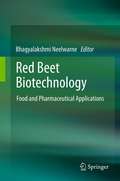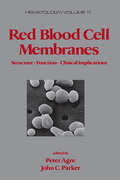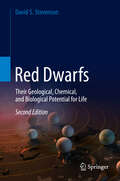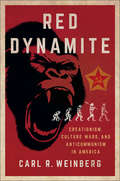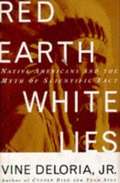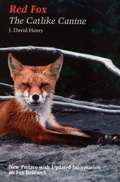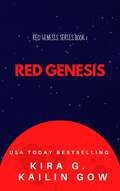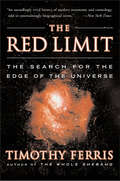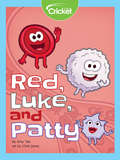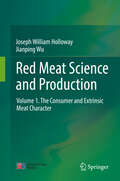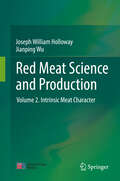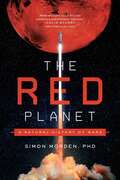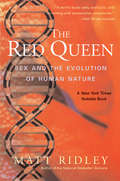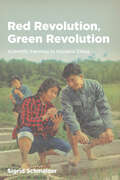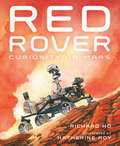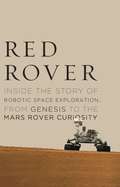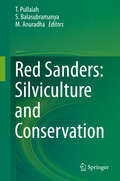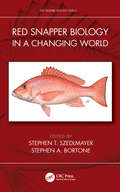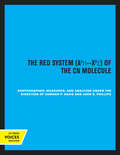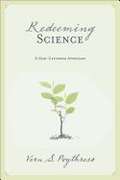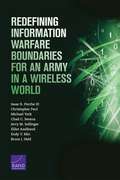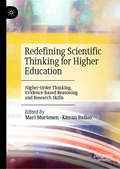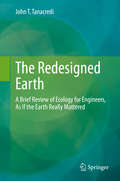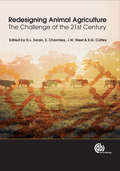- Table View
- List View
Red Beet Biotechnology
by Bhagyalakshmi NeelwarneBiotechnology is a rapidly growing research area which is immediately translated into industrial applications. Although over 1000 research papers have emerged on various aspects of red beet and the chemistry of betalaines pigments, surprisingly no comprehensive book is available. The proposed Red Beet book encompasses a scholarly compilation of recent biotechnological research developments made in basic science, biochemistry of the chief components, technological developments in augmenting and recovery of such useful compounds and value-added products with discussions on future perspectives. The book will provide detailed information of the chemistry of the main components of normal and genetically engineered beetroot.
Red Blood Cell Membranes: Structure: Function: Clinical Implications
by Peter Agre; John C. ParkerThis book is devoted to the red blood cell membrane, its structure and function, and abnormalities in disease states. It presents a well-documented and well-illustrated comprehensive picture of clinical manifestations of red blood cell disorders.
Red Dwarfs: Their Geological, Chemical, and Biological Potential for Life (Astronomers' Universe Ser.)
by David S. StevensonThis thought-provoking book looks at the nature of red dwarf systems as potential homes for life. Realistically, what are the prospects for life on these distant worlds? Could life evolve and survive there? How do these planetary surfaces and geologies evolve? How would life on a planet orbiting a red dwarf differ from life on Earth? And what are the implications for finding further habitable worlds in our galaxy?The author provides readers with insight into the habitability of planets and how this changes as time progresses and the central star evolves. Since the previous 2013 edition Under a Crimson Sun, there has been a rise in newly discovered planets orbiting red dwarfs, accompanied by controversial areas of research that test what we think we know about these systems. This revised edition delves into the wealth of new material uncovered since that date. It explains the often conflicting results and analyses put forward and clarifies our understanding of these exciting new worlds. The chapters explore the full width of relevant scientific discovery and speculation on the potential for red dwarf planets to host life. New content includes improved atmospheric models, new understandings of the impact of stellar radiation on the atmosphere of red dwarf worlds, tidal-locking, and comparisons with terrestrial geology and climate.
Red Dynamite: Creationism, Culture Wars, and Anticommunism in America (Religion and American Public Life)
by Carl R. WeinbergIn Red Dynamite, Carl R. Weinberg argues that creationism's tenacious hold on American public life depended on culture-war politics inextricably embedded in religion. Many Christian conservatives were convinced that evolutionary thought promoted immoral and even bestial social, sexual, and political behavior. The "fruits" of subscribing to Darwinism were, in their minds, a dangerous rearrangement of God-given standards and the unsettling of traditional hierarchies of power. Despite claiming to focus exclusively on science and religion, creationists were practicing politics. Their anticommunist campaign, often infused with conspiracy theory, gained power from the fact that the Marxist founders, the early Bolshevik leaders, and their American allies were staunch evolutionists. Using the Scopes "Monkey" Trial as a starting point, Red Dynamite traces the politically explosive union of Darwinism and communism over the next century. Across those years, social evolution was the primary target of creationists, and their "ideas have consequences" strategy instilled fear that shaped the contours of America's culture wars. By taking the anticommunist arguments of creationists seriously, Weinberg reveals a neglected dimension of antievolutionism and illuminates a source of the creationist movement's continuing strength. Thanks to generous funding from Indiana University and its participation in TOME (Toward an Open Monograph Ecosystem), the ebook editions of this book are available as Open Access volumes from Cornell Open (cornellpress.cornell.edu/cornell-open) and other repositories.
Red Earth, White Lies: Native Americans and the Myth of Scientific Fact
by Vine Deloria Jr.Deloria (history, law, religious studies, political science, U. of Colorado-Boulder), author of the best-selling "Custer Died For Your Sins", examines modern science as it relates to Native American oral history and exposes the myth of scientific fact, defending Indian accounts of natural history and population movement. He demonstrates how scientists manipulate data to fit their theories and documents traditional knowledge of Indian tribes in areas such as evolution, planetary history, the origin of humans, and natural disasters.
Red Fox: The Catlike Canine
by J. David HenryIn this engaging introduction to the red fox (Vulpes vulpes), J. David Henry recounts his years of field research on this flame-colored predator. With its catlike whiskers, teeth, and paws, as well as vertical-slit pupils, the North American red fox not only resembles but often behaves like a feline, especially when hunting. Probing the reasons for these similarities, Henry reveals the behavior and ecology of a species that thrives from the edge of suburbia to the cold northern tundra.
Red Genesis (Red Genesis #1)
by Kailin Gow Kira G.From USA Today Bestselling and ALA YALSA Award-winning Authors Kailin Gow and Kira G. comes a Science Fiction Post-Apocalypse Thriller. If you liked Bird Box and The Quiet Place, you will enjoy RED GENESIS.Evie was born on a new Earth that had no oxygen. When she was only 13 years old, her mother had to step outside of their underground shelter for an errand. She had been missing ever since. But with her mother's careful instructions and training, Evie has been able to survive for the last 5 years.She knows there are dangerous creatures outside of the underground shelter who travel with the wind and feeds on people's fear. They have killed many humans on the surface when they first appeared. Did her mother meet the same demise? Now at 18 years old with the shelter deteriorating and in need of fresh supplies, Evie is about to embark on the same errand and face the deadly creatures above. What will she find and can she survive? This is a STEM/ELA Literary Book for Age 14 and Up and includes STEM and ELA Literary Discussion Questions.
The Red Limit: The Search for the Edge of the Universe
by Timothy FerrisFor centuries, it was assumed that our universe was static. In the late 1920s, astronomers defeated this assumption with a startling new discovery. From Earth, the light of distant galaxies appeared to be red, meaning that those galaxies were receding from us. This led to the revolutionary realization that the universe is expanding. The Red Limit is the tale of this discovery, its ramifications, and the passionately competitive astronomers who charted the past, present, and future of the cosmos.
Red, Luke, and Patty
by Amy TaoRed is a red blood cell. Luke is a leukocyte, or white blood cell. Patty is a platelet. What do these three have in common? They are the workers in your blood. Read to find out why each worker is important for your body.
Red Meat Science and Production: Volume 1. The Consumer and Extrinsic Meat Character
by Joseph William Holloway Jianping WuThis book comprehensively describes the biological underpinnings of red meat production, discussing the current state of the science in the context of the provision of red meat products perceived by consumers to offer a quality eating experience. Covering advances in the science of red meat production, it focuses on production system elements that affect product quality. The chapters explore the latest developments in the determination of consumer preferences, and interpret of these preferences in terms of quality characteristics of red meat, investigating the science-based orchestration of red meat production to achieve product consistency. The book highlights topics such as consumer preferences, the biological and production system elements affecting red meat safety, and the intrinsic (appearance, aroma, and sensory quality) and extrinsic (humane animal and environmentally friendly production) characteristics of red meat. For each characteristic, it discusses the underlying biological and biochemical processes and examines means of altering production systems to impact consumer eating experiences. The book also features a perspective on creating holistic integrated systems for producing red meats to meet consumers’ expectations around the globe. Written by leading authorities in the area of global red meat production systems, it is a comprehensive resource for consumer-oriented red meat producers.
Red Meat Science and Production: Volume 2. Intrinsic Meat Character
by Joseph William Holloway Jianping WuThis book comprehensively describes the biological underpinnings of red meat production, discussing the current state of the science in the context of the provision of red meat products perceived by consumers to offer a quality eating experience. Covering advances in the science of red meat production, it focuses on production system elements that affect product quality. The chapters explore the latest developments in the determination of consumer preferences, and interpret of these preferences in terms of quality characteristics of red meat, investigating the science-based orchestration of red meat production to achieve product consistency. The book highlights topics such as consumer preferences, the biological and production system elements affecting red meat safety, and the intrinsic (appearance, aroma, and sensory quality) and extrinsic (humane animal and environmentally friendly production) characteristics of red meat. For each characteristic, it discusses the underlying biological and biochemical processes and examines means of altering production systems to impact consumer eating experiences. The book also features a perspective on creating holistic integrated systems for producing red meats to meet consumers’ expectations around the globe. Written by leading authorities in the area of global red meat production systems, it is a comprehensive resource for consumer-oriented red meat producers.
Red Pandas: A Natural History
by Dorcas MacclintockDescribes the physical characteristics, habitat, behavior, and life cycle of the small long-tailed red panda of Asia.
The Red Planet: A Natural History of Mars
by Ph.D. Simon MordenUncover the mysteries, wonders, and history of Mars—as close to an eye-witness perspective of the incredible Red Planet as any reader can get.The history of Mars is drawn not just on its surface, but also down into its broken bedrock and up into its frigid air. Most of all, it stretches back into deep time, where the trackways of the past have been obliterated and there is no discernible trace of where they started from or how they travelled, only where they ended up. From the planet&’s formation 4.5 billion years ago, through eras that featured cataclysmic meteor strikes, explosive volcanoes and a vast ocean that spanned the entire upper hemisphere, to the long, frozen ages that saw its atmosphere steadily thinning and leaking away into space, planetary geologist Dr. Simon Morden presents a tantalizing vision of our nearest neighbour, its dramatic history, and astonishing present.
The Red Queen: Sex and the Evolution of Human Nature (Penguin Press Science Ser.)
by Matt RidleyReferring to Lewis Carroll's Red Queen from Through the Looking-Glass, a character who has to keep running to stay in the same place, Matt Ridley demonstrates why sex is humanity's best strategy for outwitting its constantly mutating internal predators. The Red Queen answers dozens of other riddles of human nature and culture -- including why men propose marriage, the method behind our maddening notions of beauty, and the disquieting fact that a woman is more likely to conceive a child by an adulterous lover than by her husband. Brilliantly written, The Red Queen offers an extraordinary new way of interpreting the human condition and how it has evolved.
Red Revolution, Green Revolution: Scientific Farming in Socialist China
by Sigrid SchmalzerIn 1968, the director of USAID coined the term "green revolution" to celebrate the new technological solutions that promised to ease hunger around the world--and forestall the spread of more "red," or socialist, revolutions. Yet in China, where modernization and scientific progress could not be divorced from politics, green and red revolutions proceeded side by side. In Red Revolution, Green Revolution, Sigrid Schmalzer explores the intersection of politics and agriculture in socialist China through the diverse experiences of scientists, peasants, state agents, and "educated youth." The environmental costs of chemical-intensive agriculture and the human costs of emphasizing increasing production over equitable distribution of food and labor have been felt as strongly in China as anywhere--and yet, as Schmalzer shows, Mao-era challenges to technocracy laid important groundwork for today's sustainability and food justice movements. This history of "scientific farming" in China offers us a unique opportunity not only to explore the consequences of modern agricultural technologies but also to engage in a necessary rethinking of fundamental assumptions about science and society.
Red Rover: Curiosity on Mars
by Richard HoRed Rover is a gorgeously illustrated tale that explores the vast, inhospitable landscape of Mars and the adventures of the little rover that calls the planet its home.Mars has a visitor.It likes to roam...observe...measure...and collect.It explores the red landscape—crossing plains, climbing hills, and tracing the bottoms of craters—in search of waterand life.It is not the first to visit Mars.It will not be the last.But it might be...the most curious.Join Curiosity on its journey across the red planet in this innovative and dynamic nonfiction picture book by Richard Ho, illustrated by Sibert Honor winner Katherine Roy.This title has Common Core connections.
Red Rover: Inside the Story of Robotic Space Exploration, from Genesis to the Mars Rover Curiosity
by Roger WiensFor centuries humankind has fantasized about life on Mars, whether it’s intelligent Martian life invading our planet (immortalized in H. G. Wells’s The War of the Worlds) or humanity colonizing Mars (the late Ray Bradbury’s The Martian Chronicles). The Red Planet’s proximity and likeness to Earth make it a magnet for our collective imagination. Yet the question of whether life exists on Mars--or has ever existed there--remains an open one. Science has not caught up to science fiction--at least not yet. This summer we will be one step closer to finding the answer. On August 5th, Curiosity--a one-ton, Mini Cooper-sized nuclear-powered rover--is scheduled to land on Mars, with the primary mission of determining whether the red planet has ever been physically capable of supporting life. In Getting to Mars, Roger Wiens, the principal investigator for the ChemCam instrument on the rover--the main tool for measuring Mars’s past habitability--will tell the unlikely story of the development of this payload and rover now blasting towards a planet 354 million miles from Earth. ChemCam (short for Chemistry and Camera) is an instrument onboard the Curiosity designed to vaporize and measure the chemical makeup of Martian rocks. Different elements give off uniquely colored light when zapped with a laser; the light is then read by the instrument’s spectrometer and identified. The idea is to use ChemCam to detect life-supporting elements such as carbon, nitrogen, and oxygen to evaluate whether conditions on Mars have ever been favorable for microbial life. This is not only an inside story about sending fantastic lasers to Mars, however. It’s the story of a new era in space exploration. Starting with NASA’s introduction of the Discovery Program in 1992, smaller, scrappier, more nimble missions won out as behemoth manned projects went extinct. This strategic shift presented huge opportunities--but also presented huge risks for shutdown and failure. And as Wiens recounts, his project came close to being closed down on numerous occasions. Getting to Mars is the inspiring account of how Wiens and his team overcame incredible challenges--logistical, financial, and political--to successfully launch a rover in an effort to answer the eternal question: is there life on Mars?
Red Sanders: Silviculture and Conservation
by T. Pullaiah S. Balasubramanya M. AnuradhaPterocarpus santalinus L.f., popularly known as Red Sanders, an endemic tree, belonging to the family Fabaceae is confined to the southern parts of Eastern Ghats. IUCN has listed this tree as endangered. The plant has superlative characteristics in its wood and has many medicinal properties. This plant has attracted the attention of both foresters and lay man because of its high valued wood which is being illegally harvested creating law and order problem. This book is a comprehensive monograph on Red Sanders and is divided into 15 chapters. The book provides information on taxonomy, morphology, distribution, wood anatomy, wood properties and uses, dye principle, phytochemistry, pharmacology, Silvicultural aspects, propagation, cultivation practices, reproductive biology, pests and diseases, biotechnology, molecular studies, conservation, trade, commerce, socioeconomic aspects of Red Sanders, and grey areas of research. The book is profusely illustrated with colour photographs and line drawings. Relevant references have been provided under each chapter. This monograph on Red Sanders with systematic representation of information and illustrations will be a desk reference and field guide to foresters, botanists, researchers, farmers, traders and environmentalists.
Red Snapper Biology in a Changing World (CRC Marine Biology Series)
by Stephen T. Szedlmayer Stephen A. BortoneRed Snapper Lutjanus campechanus, is an important commercial and recreational fish species and there has been much interest in maintaining its status among a variety of scientific, social and economic levels. Stocks are influenced by varying environmental conditions, changing fishing effort and efficiency, anthropogenic effects, inter- and intraspecific interactions, bycatch from other fisheries, and habitat alterations. Red Snapper Biology in a Changing World explores these changing factors and their potential effects on Red Snapper in the Eastern Atlantic region including the Gulf of Mexico and Southeastern U.S. The book will provide a better understanding of Red Snapper population fluctuations that will subsequently allow for better management decisions and more informed user groups in their efforts to maintain a sustainable fishery. It explores the responses Red Snapper have made, and are making, relative to their life history attributes such as early life history and adult ecology, especially attributes associated with population distribution and abundance, movement patterns, fish health issues and management success. A compendium of many papers presented at the 147th annual meeting of the American Fisheries Society in Tampa, Florida, this volume also includes additional research completed as a result of the symposium. It will be essential reading for fisheries scientists and managers, ichthyologists, resource and environmental managers, and policymakers who are involved with coastal fisheries.
The Red System of the CN Molecule (Berkeley Analyses of Molecular Spectra #1)
by Sumner P. Davis John G. PhillipsThis title is part of UC Press's Voices Revived program, which commemorates University of California Press’s mission to seek out and cultivate the brightest minds and give them voice, reach, and impact. Drawing on a backlist dating to 1893, Voices Revived makes high-quality, peer-reviewed scholarship accessible once again using print-on-demand technology. This title was originally published in 1963.
Redeeming Science: A God-centered Approach
by Vern S. PoythressMany people think science is antagonistic to Christian belief. Science, it is said, shows that the universe is billions of years old, while the Bible says it is only thousands of years old. And some claim that science shows supernatural miracles are impossible. These and other points of contention cause some Christians to view science as a threat to their beliefs. <p><p> Redeeming Science attempts to kindle our appreciation for science as it ought to be-science that could serve as a path for praising God and serving fellow human beings. Through examining the wonderfully complex and immutable laws of nature, author Vern Poythress explains, we ought to recognize the wisdom, care, and beauty of God. A Christian worldview restores a true response to science, where we praise the God who created nature and cares for it.
Redefining Information Warfare Boundaries For An Army In A Wireless World
by Isaac R. Porche III Christopher Paul Michael York Chad C. Serena Jerry M. Sollinger Elliot Axelband Endy Y. Min Bruce J. HeldThe U. S. Army is studying ways to apply its cyber power and is reconsidering doctrinally defined areas that are integral to cyberspace operations. An examination of network operations, information operations, and several other, more focused areas across the U. S. military found significant overlap and potential boundary progression that could inform the development of future Army doctrine.
Redefining Scientific Thinking for Higher Education: Higher-Order Thinking, Evidence-Based Reasoning and Research Skills
by Mari Murtonen Kieran BallooThis book examines the learning and development process of students’ scientific thinking skills. Universities should prepare students to be able to make judgements in their working lives based on scientific evidence. However, an understanding of how these thinking skills can be developed is limited. This book introduces a new broad theory of scientific thinking for higher education; in doing so, redefining higher-order thinking abilities as scientific thinking skills. This includes critical thinking and understanding the basics of science, epistemic maturity, research and evidence-based reasoning skills and contextual understanding. The editors and contributors discuss how this concept can be redefined, as well as the challenges educators and students may face when attempting to teach and learn these skills. This edited collection will be of interest to students and scholars of student scientific skills and higher-order thinking abilities.
The Redesigned Earth: A Brief Review of Ecology for Engineers, As If the Earth Really Mattered
by John T. TanacrediThis book provides insight into the basic aspects of ecology that impact or are affected by engineering practices. Ecological principals are described and discussed through the lens of the influences that built structures have on the Earth’s biological, geological, and chemical systems. The text goes on to elucidate the engineering influences that have or will influence the face of the Earth. These influences redesign the Earth, either by destroying natural systems and replacing them with highly subsidized systems or by attempting to restore highly disturbed or contaminated systems with the basic natural systems that were originally present.
Redesigning Animal Agriculture: The Challenge of the 21st Century
by David L. Swain Ed Charmley John Steel Shaun CoffeyFocusing on livestock production systems, this comprehensive text addresses how the growing diversity of global food demands will be met in the future, providing insights into new and emerging scientific areas and the implications for addressing global drivers for change.
